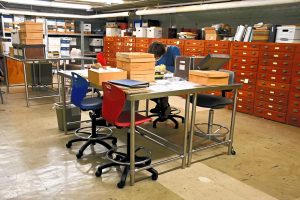UMaine Anthropology Laboratories
Forensic Anthropology Laboratory
The Forensic Anthropology Laboratory is the center for conducting research on human osteology, bioarchaeology, forensics, and taphonomy. The lab is also the focal point for training undergraduate and graduate students in the major methods and techniques used in forensics. Research and training is designed to prepare students in the analysis human remains in forensic, modern, and prehistoric situations with a particular eye toward taphonomic assessment. The forensic laboratory contains an extensive comparative human skeletal collection representing individuals from fetal to older adult as well as males and females. The lab is currently being developed and will be equipped with the necessary tools with which to conduct modern forensic analyses.
The Forensic Anthropology Lab is directed by Dr. Marcella Sorg.
Material Cultures Laboratory
The Material Culture Laboratory is currently being developed and will be equipped with the necessary tools with which to conduct material culture analyses.
The Material Cultures Lab will be directed by Dr. Matthew Magnani and Dr. Natalia Magnani.
Northeast Archaeology Laboratory

The Northeast Archaeology Lab is the center of research and analysis of past material culture of the Indigenous peoples of Maine and the Maritimes. The lab provides space for teaching and research on collections generated from over fifty years of archaeological research.The collection covers temporal range from roughly 12,000 years ago up to the more historic present.
Projects carried out in the Northeast Archaeology Lab include:
- Analysis of material culture excavated during the UMaine Archaeological Field School.
- Archaeological lithic, ceramic, and faunal analyses on collections from Maine and the Canadian Maritimes.
- Theses and dissertation studies carried out by UMaine students in the Anthropology and Environmental program and the Climate Change Institute
- Archaeological shell heap studies.
The Northeast Archaeology Lab is directed by Dr. Bonnie Newsom.
Zooarchaeology Laboratory
The Zooarchaeology Laboratory is the center for training undergraduate and graduate students in the major methods and techniques used in archaeological faunal analysis. Research and training is designed to prepare students in the analysis of animal remains from archaeological sites, and from these analyses infer past lifeways, paleo-environments, and prehistoric human adaptations. The zooarchaeology laboratory contains an extensive modern comparative skeletal collection of northeastern and southwestern fauna. The lab is equipped with the necessary tools with which to conduct faunal research, including a fume hood, Nikon microscopes, computers and spaced for analyses and storage. Projects currently being conducted in the lab:
- Paleonutrition – analyses of prehistoric diet, health, and nutrition is a constant theme of research conducted in the lab. Currently, we are analyzing bones, botanical remains, pollen, and DNA from southwestern Texas paleofeces to determine ancient diet and diseases, sex differences, and migratory patterns.
- Prehistoric Northeastern Adaptations – analyses of faunal remains from coastal Maine shell midden sites to determine prehistoric animal use as they relate to diet, migratory patterns, and prehistoric land use.
- Zoogeography Project of Maine – analysis of the prehistoric faunal record to map migrations and extinctions of extant and extinct species through time and across space in prehistoric Maine and the maritime Provinces.
- Southwestern Zooarchaeology – analysis of faunal remains from Singuan, Anasazi, and Big Bend, Texas archaeological sites to determine changes in prehistoric land use, diet, and migrations through time.
The Zooarchaeology Lab is directed by Anthropology Staff.
South American Archaeology Laboratory

The South American Archaeology Lab in South Stevens Hall constitutes the primary work space for a growing team of researchers investigating the quaternary and human prehistory of South America. The lab contains two computers (Mac and PC), Geographic Information System software, flatbed photo and slide scanners, a printer, two microscopes, an extensive library of archaeological and quaternary science books and journals, and an archive of South American maps and air photos. The lab also houses a robust malacological reference collection and selected archaeological materials from UMaine excavations on loan from Peru. Aside from regular research functions, the lab is used for the preparation of archaeological materials for rock provenance studies, prehistoric artifact analyses, and archival preparation.
Projects carried out in the South American Archaeology Lab include:
- Analyzing ancient shells and bones to decipher the of prehistoric Peruvians;
- Using the same remains as clues to climatic conditions of the past, such as the prehistory of El Niño;
- Working with artifacts and geological samples of obsidian and other stones to reconstruct technology and track down the very places ancient people visited to get their raw material; and
- Processing digital data in a Geographic Information System to model early human behavior across the landscapes of Andean South America.
Each of these projects grows out of extensive field work by UMaine researchers in South America—our teams launch one or more expeditions every year to gather new information about ancient Americans and their world.
The South American Archaeology Lab is directed by Dr. Dan Sandweiss




